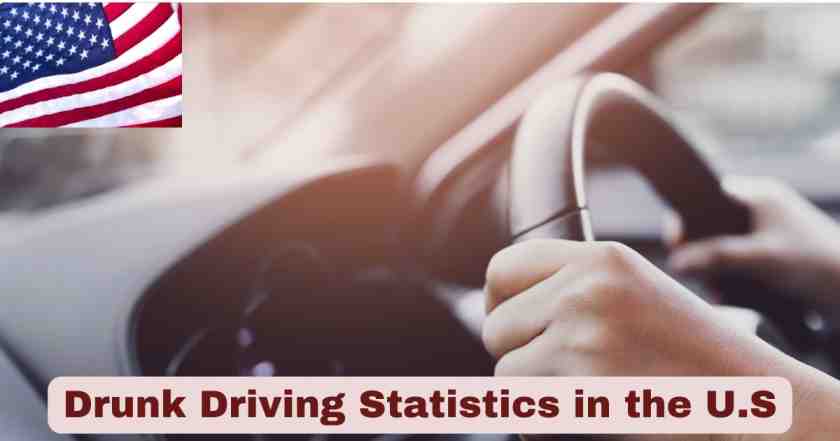Drunk Driving in the U.S. in 2025
Drunk driving remains one of the most persistent and preventable causes of traffic deaths across the United States. Despite decades of awareness campaigns, stricter laws, and technological advances, the statistics paint a sobering picture of the ongoing battle against alcohol-impaired driving. The latest data reveals that 34 people die every day in drunk-driving crashes, representing one death every 42 minutes. These numbers underscore the urgent need for continued vigilance and comprehensive strategies to combat this deadly behavior.
The scope of drunk driving’s impact extends far beyond the individual driver, affecting families, communities, and the entire nation’s roadway safety. With 12,429 people killed in 2023 alone due to alcohol-impaired driving crashes, the United States continues to grapple with a crisis that claims more lives than many other preventable causes of death. The financial burden is equally staggering, with alcohol-impaired driving crashes costing the nation $68.9 billion annually based on recent calculations, highlighting both the human and economic toll of this entirely preventable tragedy.
Key Drunk Driving Facts in the U.S. 2025
| Statistic | Value | Source |
|---|---|---|
| Daily Deaths from Drunk Driving | 34 people | NHTSA 2023 |
| Death Frequency | 1 every 42 minutes | NHTSA 2023 |
| Total Deaths in 2023 | 12,429 people | NHTSA 2023 |
| Percentage of All Traffic Deaths | 30% | NHTSA 2023 |
| Annual Cost to Society | $68.9 billion | NHTSA 2019 |
| Legal BAC Limit (Most States) | 0.08 g/dL | NHTSA |
| Legal BAC Limit (Utah) | 0.05 g/dL | NHTSA |
| Children Killed (Ages 0-14) | 229 children | CDC 2020 |
| Motorcycle Fatalities (Alcohol-Related) | 1,668 deaths | NHTSA 2023 |
| Repeat Offender Rate | 6 times higher | NHTSA 2023 |
Drunk driving remains a critical public safety issue in the U.S. in 2025. According to the latest data, 34 people die every day due to drunk driving, equating to one death every 42 minutes. In total, 12,429 people lost their lives in 2023, with alcohol-impaired driving accounting for 30% of all traffic-related deaths. The financial burden is equally staggering, with an estimated $68.9 billion in annual costs to society. While most U.S. states maintain a legal blood alcohol concentration (BAC) limit of 0.08 g/dL, Utah enforces a stricter 0.05 g/dL limit to reduce impaired driving incidents.
The impact of drunk driving extends to vulnerable populations as well. In 2020, 229 children aged 0–14 were tragically killed in alcohol-related crashes. Motorcyclists are also disproportionately affected, with 1,668 alcohol-related motorcycle fatalities recorded in 2023. The problem is exacerbated by repeat offenders, who are 6 times more likely to be involved in a fatal crash. These alarming figures highlight the ongoing need for tougher enforcement, public education, and legislative efforts to prevent further loss of life on American roads.
Drunk Driving Deaths in the U.S. 2025
| Year | Total Deaths | Daily Average | Percentage Change |
|---|---|---|---|
| 2023 | 12,429 | 34 | +5.2% |
| 2022 | 11,815 | 32 | -1.8% |
| 2021 | 12,032 | 33 | +7.5% |
| 2020 | 11,654 | 32 | +14.3% |
| 2019 | 10,196 | 28 | -5.3% |
The annual trend in drunk driving deaths reveals a concerning pattern of fluctuation with an overall upward trajectory in recent years. The 2023 figure of 12,429 deaths represents a significant 5.2% increase from the previous year, marking the highest number of alcohol-impaired driving fatalities in over a decade. This increase is particularly alarming given the extensive resources dedicated to drunk driving prevention and the widespread availability of alternative transportation options.
The 14.3% spike in 2020 coincided with the COVID-19 pandemic, when many expected decreased driving to result in fewer fatalities. However, the data suggests that while overall traffic volume decreased, the proportion of impaired drivers on the road increased significantly. The subsequent years have shown that this trend has persisted, with 2023’s 12,429 deaths representing not just a statistical increase but thousands of preventable tragedies that have devastated families and communities across the nation.
Blood Alcohol Concentration Impact in the U.S. 2025
| BAC Level | Crash Risk Multiplier | Typical Effects | Driving Impairment |
|---|---|---|---|
| 0.02 g/dL | 1.4x | Slight mood alteration | Declined visual tracking |
| 0.05 g/dL | 2.0x | Reduced coordination | Difficulty steering |
| 0.08 g/dL | 4.0x | Poor muscle coordination | Impaired concentration |
| 0.10 g/dL | 7.0x | Slurred speech | Reduced lane control |
| 0.15 g/dL | 12.0x | Major loss of balance | Substantial vehicle control loss |
The relationship between blood alcohol concentration and crash risk demonstrates an exponential increase in danger as BAC levels rise. Even at the relatively low level of 0.02 g/dL, drivers face a 40% increased risk of being involved in a crash compared to sober drivers. This finding challenges the common misconception that only heavily intoxicated drivers pose a significant risk on the roadways.
The legal limit of 0.08 g/dL in most states represents a 4-fold increase in crash risk, while drivers with a BAC of 0.15 g/dL face a staggering 12 times higher risk of causing a fatal crash. In 2023, there were 2,117 people killed in alcohol-related crashes where the driver had a BAC between 0.01 and 0.07 g/dL, proving that even below the legal limit, alcohol significantly impairs driving ability and increases the likelihood of deadly outcomes.
Age Demographics of Drunk Driving Deaths in the U.S. 2025
| Age Group | Percentage of Fatal Crashes | Estimated Deaths | Risk Factors |
|---|---|---|---|
| 21-24 years | 29% | 3,604 | Inexperience, binge drinking |
| 25-34 years | 28% | 3,480 | Peak drinking years |
| 35-44 years | 18% | 2,237 | Established drinking patterns |
| 45-54 years | 12% | 1,491 | Chronic alcohol issues |
| 55+ years | 13% | 1,616 | Medication interactions |
The age distribution of drunk driving fatalities reveals that young adults bear the heaviest burden of alcohol-impaired driving deaths. The 21-24 age group accounts for 29% of all fatal alcohol-impaired crashes, representing approximately 3,604 deaths in 2023. This demographic faces unique challenges including inexperience with both alcohol and driving, tendency toward binge drinking, and often insufficient understanding of alcohol’s effects on driving ability.
The 25-34 age group follows closely at 28%, with an estimated 3,480 deaths in 2023. Together, these two age groups represent 57% of all drunk driving deaths, highlighting the critical need for targeted intervention programs for young adults. The implementation of minimum drinking age laws has been shown to save over 31,959 lives from 1975 to 2017, demonstrating the effectiveness of age-based prevention strategies, yet the continued high rates among young adults indicate that additional measures are needed.
Gender Distribution of Drunk Driving Deaths in the U.S. 2025
| Gender | Percentage of Drunk Drivers | Estimated Deaths | Risk Ratio |
|---|---|---|---|
| Male | 80% | 9,943 | 4:1 |
| Female | 20% | 2,486 | 1:4 |
The gender disparity in drunk driving deaths is stark, with men accounting for 80% of all alcohol-impaired driving fatalities in 2023. This translates to approximately 9,943 male deaths compared to 2,486 female deaths, representing a 4:1 ratio. This overwhelming male predominance in drunk driving fatalities reflects broader patterns of alcohol consumption, risk-taking behavior, and driving habits among men compared to women.
The four-to-one male-to-female ratio in drunk driving deaths has remained relatively consistent over the past decade, suggesting that gender-specific prevention strategies may be necessary to address this disparity. Men are more likely to engage in binge drinking, more likely to drive after drinking, and more likely to drive with higher BAC levels. Understanding these behavioral differences is crucial for developing targeted interventions that can effectively reduce the disproportionate impact of drunk driving on male drivers and their victims.
Motorcycle Drunk Driving Deaths in the U.S. 2025
| Statistic | Value | Percentage | Details |
|---|---|---|---|
| Total Motorcycle Deaths | 6,335 | 100% | All motorcycle fatalities |
| Alcohol-Impaired Deaths | 1,668 | 26% | Highest among vehicle types |
| Ages 35-39 | 568 | 34% | Highest risk age group |
| Ages 45-49 | 568 | 34% | Equally high risk |
Motorcycle riders face the highest percentage of alcohol-impaired driving deaths among all vehicle types, with 26% of motorcycle fatalities in 2023 involving alcohol-impaired operators. This represents 1,668 deaths out of 6,335 total motorcycle fatalities, highlighting the particularly deadly combination of alcohol and motorcycle operation. The lack of protective barriers, increased vulnerability to weather and road conditions, and the enhanced skill requirements for motorcycle operation make alcohol impairment especially dangerous for these riders.
The age distribution of alcohol-impaired motorcycle deaths shows that riders aged 35-39 and 45-49 each account for 34% of drunk motorcycle fatalities. This pattern differs from passenger vehicle drunk driving deaths, which peak in younger age groups. The higher age profile for motorcycle drunk driving deaths may reflect the demographics of motorcycle ownership and the tendency for middle-aged riders to combine recreational riding with alcohol consumption at bars, restaurants, and social events.
Child Victims of Drunk Driving in the U.S. 2025
| Age Group | Deaths | Percentage of Child Traffic Deaths | Passenger Status |
|---|---|---|---|
| 0-14 years | 229 | 21% | 52% in drunk driver’s vehicle |
| 15-20 years | 1,491 | 30% | Various passenger scenarios |
The impact of drunk driving on children represents one of the most heartbreaking aspects of this preventable tragedy. In 2020, 229 children ages 0-14 were killed in crashes involving alcohol-impaired drivers, accounting for 21% of all traffic-related deaths in this age group. Even more disturbing is that 52% of these child victims were passengers in the vehicle driven by the drunk driver, meaning they were killed by someone they likely trusted.
The data reveals that children are not just innocent bystanders but direct victims of adult decision-making regarding alcohol and driving. The 30% of young drivers aged 15-20 who were killed in crashes and had BACs of 0.01 g/dL or higher demonstrates that underage drinking and driving remains a persistent problem despite the legal drinking age of 21. These statistics underscore the urgent need for comprehensive prevention programs that protect children both as passengers and as young drivers themselves.
Economic Impact of Drunk Driving in the U.S. 2025
| Cost Category | Annual Cost | Per Incident | Details |
|---|---|---|---|
| Total Annual Cost | $68.9 billion | $5.5 million | Based on 2019 data |
| Medical Costs | $13.8 billion | $1.1 million | Immediate and long-term care |
| Lost Productivity | $35.2 billion | $2.8 million | Lifetime earnings lost |
| Legal Costs | $7.8 billion | $628,000 | Court and enforcement |
| Property Damage | $12.1 billion | $973,000 | Vehicle and infrastructure |
The economic burden of drunk driving extends far beyond the immediate costs of crashes, reaching $68.9 billion annually based on the most recent comprehensive analysis. This staggering figure represents not just the direct costs of emergency response, medical treatment, and property damage, but also the long-term economic impact of lives lost and productivity destroyed. When broken down per incident, each drunk driving crash costs society an average of $5.5 million in direct and indirect costs.
The largest component of these costs is lost productivity at $35.2 billion annually, representing the economic value of lives cut short and careers ended by drunk driving crashes. Medical costs account for $13.8 billion, reflecting both immediate emergency treatment and long-term care for survivors with permanent disabilities. These economic impacts ripple through families, communities, and the entire healthcare and social support systems, creating a burden that extends far beyond the initial crash scene and affects society for generations.
Prevention and Enforcement Efforts in the U.S. 2025
The fight against drunk driving requires a multifaceted approach combining education, enforcement, and technology. Current prevention strategies include sobriety checkpoints, which have proven highly effective in deterring impaired driving and removing dangerous drivers from the road. Ignition interlock devices have emerged as one of the most successful tools, preventing vehicles from starting if the driver has been drinking. These devices are increasingly mandated for convicted drunk drivers and have shown remarkable success in reducing repeat offenses.
Law enforcement agencies across the country have intensified their efforts through high-visibility enforcement campaigns, particularly during high-risk periods such as holidays and summer months. The “Drive Sober or Get Pulled Over” campaign and similar initiatives have increased public awareness and demonstrated the serious consequences of impaired driving. Additionally, the expansion of ride-sharing services and other alternative transportation options has provided practical solutions for people who want to drink responsibly without risking their lives or the lives of others on the road.
The path forward requires continued commitment from all stakeholders, including government agencies, law enforcement, healthcare providers, educators, and individual citizens. While the statistics paint a grim picture of the current state of drunk driving in America, they also highlight the critical importance of sustained prevention efforts, innovative approaches to behavior change, and unwavering dedication to the goal of eliminating drunk driving deaths entirely. Every life lost to drunk driving represents a preventable tragedy, and every prevention effort brings us closer to a future where no family has to endure the devastating loss caused by impaired driving.
Disclaimer: The data research report we present here is based on information found from various sources. We are not liable for any financial loss, errors, or damages of any kind that may result from the use of the information herein. We acknowledge that though we try to report accurately, we cannot verify the absolute facts of everything that has been represented.







